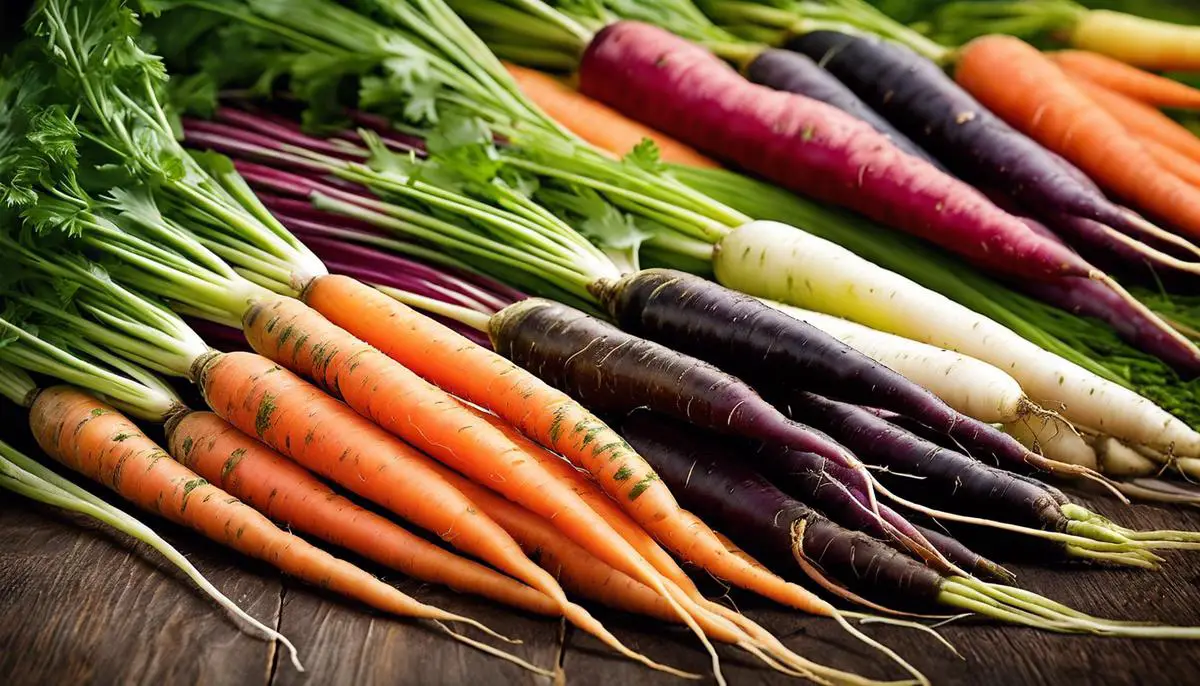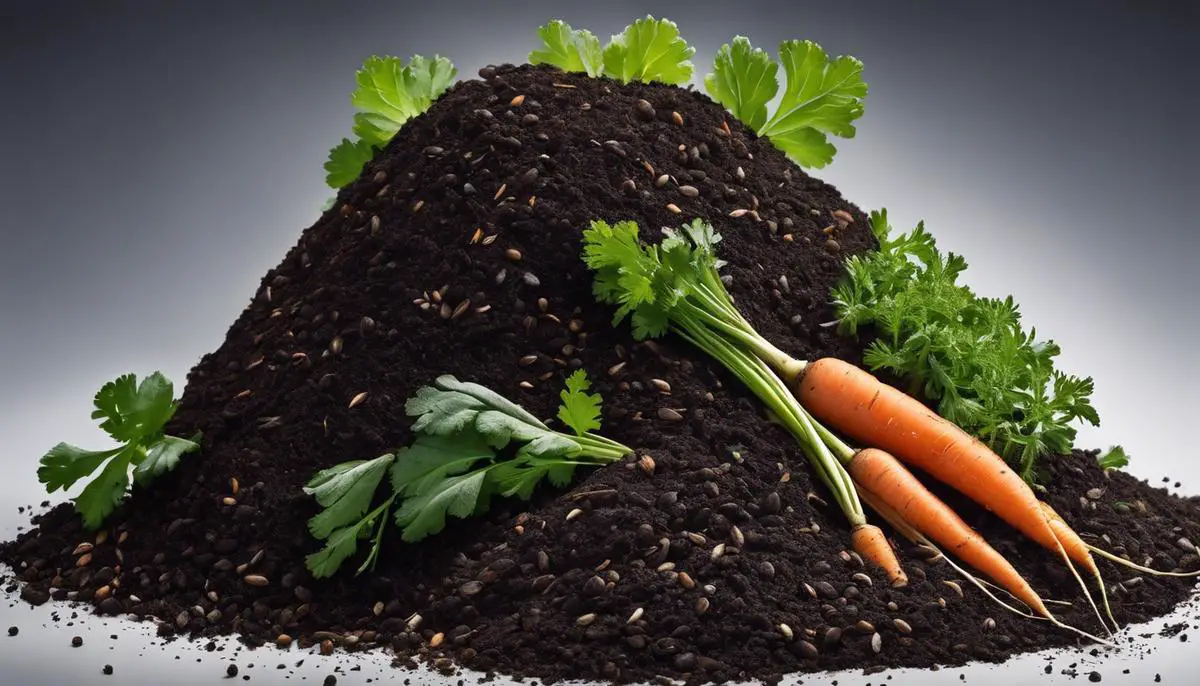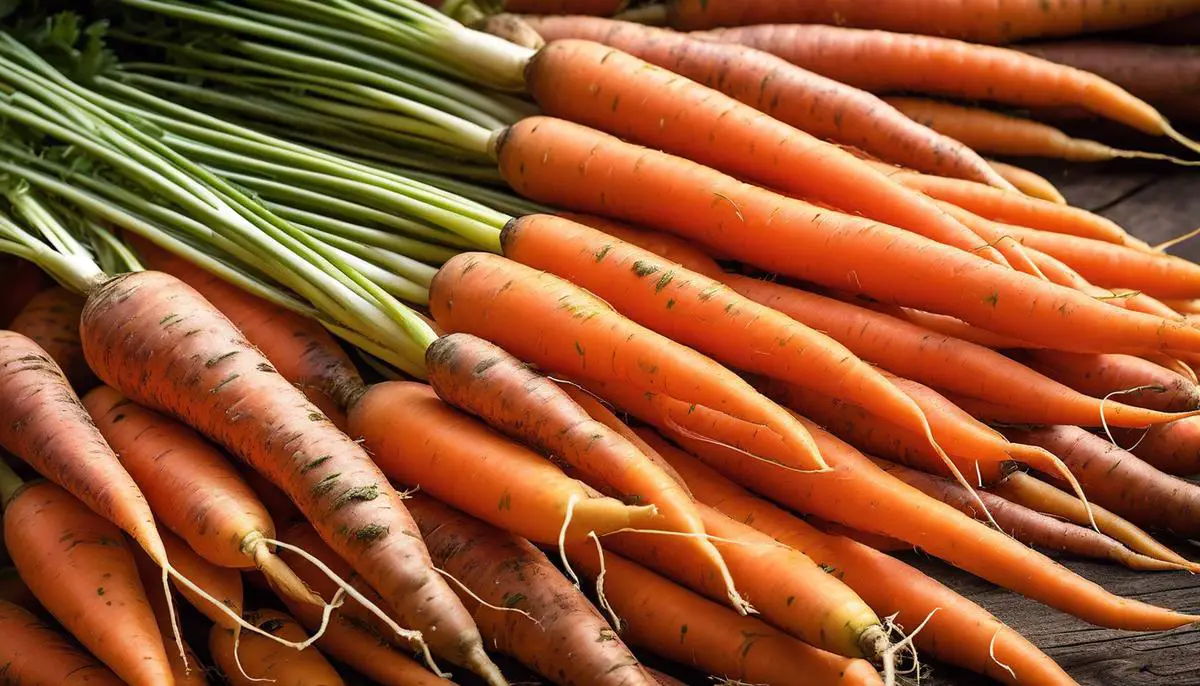Ashen, vivid orange, dark maroon, brilliant yellow – the realm of carrots is as vibrant and varied as its palette. As a multipurpose vegetable unifying health, taste, and versatility in cooking, carrots have gradually become a staple in households around the globe. However, in the pursuit of embracing sustainability and quality, homegrown organic carrots have recently gained significant limelight. This journey of organic carrot cultivation begins with the understanding of different types of carrots, their unique characteristics, and the advantages each variety holds. The odyssey continues with the preparation of the soil bed through efficient composting techniques and ends with the careful harvesting of this wholesome root vegetable. Throughout this process, one gains a beautiful understanding of the burgeoning botany and the intrinsic relationship between nature and nourishment.
Understanding the Hues: Carrot Varieties and Choosing What to Plant
Unearth the Rainbow: A Deep Dive into Organic Carrots and Choosing the Variety You’ll Love to Grow
Are you crazy about carrots? Perhaps you’ve been enthralled by the rich, earthy medley of flavors offered by organic varieties, or maybe, you’ve been wowed by the vibrant hues sported by carrots other than the typical orange. If you’ve felt the pull towards the eclectic, engaging world of organic carrot cultivation, you’re in for a vivid and rewarding journey that keeps you on your toes, your hands in the earth, and your taste buds always happily surprised.
Reader Poll: What online courses would interest you?
The first step towards donning the hat of a carrot connoisseur lies in understanding the diverse range of organic carrots on tap. Of course, the traditional ‘Nantes’ with its sweet-crisp charm and short growing period holds a robust representation. At a spitting-image resemblance but with a slightly more refined sweet flavor, the ‘Bolero’ is yet another commoner in the organic sphere.
Yet, the riot of colors doesn’t stop at sunshine orange. Flashy alternatives like the ‘Cosmic Purple’ burst with violet vibrancy on the outside, concealing a bright orange core, while the ‘Solar Yellow’ challenges the status quo with its bright lemon hue and a sweet, juicy bite that compels a second taste. For a real twist, try the ‘Black Nebula’ for a dark purple, near black exterior, and a core that ranges from purple to white.
Understanding the range is one side of the coin; picking the ideal breed for your backyard or balcony hinges on your particular predilections and the ground realities of your garden.
Subscribe to our newsletter!
For urban-dwelling green thumbs working with space constraints, shorter, stumpier varieties like the ‘Parisienne’ or ‘Romeo’ thrive. With a bonus of thriving in containers, these small but packed-with-flavor snacks would be an apt choice for city-slicker gardening enthusiasts.
For those craving a crunchy, sweet bite, the ‘Scarlet Nantes’ is a perennial favorite with its high sugar content. If you have a preference for longer growing seasons and a more relaxed gardening pace, ‘Danvers’ with an estimated growing duration of 74-75 days would align with your needs.
If clay or heavy soil lines your garden, the shorter, more robust varieties like ‘Chantenay Red Core’ would come off triumphant, ensuring you aren’t left empty-handed. On the flip side, sandy or loamy soil promises a fruitful yield for longer, slender types like ‘Imperator 58.’
An underrated yet critical criterion is considering the hardiness of the variety. For those facing harsher climates, ‘Kaleidoscope Mix’ could be a winning card with its proven resistance against colder conditions and diverse color offering, all wrapped into one.
Choosing to grow organic carrots is a delightful journey, one that promises the joy of nurturing, the wonder of witnessing growth, and the ultimate satisfaction of a fresh, flavorsome crunch right from your garden. As you learn more about the intriguing world of organic carrots, remember the mantra: understand, evaluate, and then, choose. Happy carrot cultivating, and may every harvest bring you closer to the mastery of this vibrant, versatile, and nutrition-packed marvel of nature.

Preparing the Plot: Soil Preparation and Composting
Let’s dive right into the soil preparation for organic carrot cultivation and understand the pivotal role that composting plays. Having found your perfect carrot variety, considering hardiness and type of soil you have, the next crucial step is to enhance your soil for optimal carrot growth.
Soil preparation is often an underestimated aspect of growing organic carrots, but knowledgeable gardeners will often stress the importance of getting your ground ready before sowing those carrot seeds. Carrots, as root vegetables, need loose, well-drained soil that’s free from large stones. Heavy clay and rocky soils harbor obstacles for the roots, causing them to grow malformed.
A good trick is to work the soil at least 1 foot deep. This allows those carrot roots to grow unobstructed, creating straight, long vegetables. If your garden has compact or clay soil, consider building a raised bed or growing your carrots in containers. This enables you to have control over the soil composition and takes the guesswork out of ground preparation.
Composting arrives on the scene to make the soil environment even more conducive for our organic carrot pals. A well-structured compost pile can transform your kitchen waste and garden trimmings into a nutrient-rich additive for your soil. And the best part is the compost produced is free from synthetic additives, aligning perfectly with your organic gardening principles.
Indeed, compost enhances the soil texture, moisture-holding capacity and provides slow-release nutrients to the growing carrot plants. Also, it fosters healthy soil life, ensuring your carrots have all they need to thrive. However, it’s essential to remember not to overdo the composting. Excessive organic matter may lead to hairy, disfigured carrots.
Moreover, timing is key when it comes to composting for organic carrot growth. Compost should ideally be incorporated into the soil at least 2-4 weeks before sowing. This gives the compost sufficient time to blend with the soil and create a perfect base for carrot seed germination.
Addition of green manure crops like clover or field peas can also be expedient. Being leguminous, they fix nitrogen into the soil – a top requirement for carrot growth. However, these must be turned into the soil at least 3 weeks before sowing to prevent nitrogen overload which can lead to lanky and split carrots.
With the power of knowledge, good composting techniques, and patience, anyone can cultivate a flourishing colony of organic carrots. All it needs is understanding the carrot genus in-depth, choosing the right variety, and offering them an optimized soil environment, and voila – a humble patch of soil transforms into a vibrant, orange bounty of wholesome goodness!

Cultivation Consciousness: Planting, Pest Control, and Harvesting
Diving right into where we left off, the exciting process of sowing carrot seeds beckons exploration. This is truly where the magic starts to unfold. Ensure to evenly disperse seeds in the freshly prepared, deep, well-drained soil. Spacing is key; distance each seed by a good 1-2 inches to deliver room for each carrot to thrive, growing straight and strong. For those situations when some seeds end up closer together, fear not! This is easily resolved later in the thinning stage. The first sprouts will likely peak after about 2-3 weeks, be it a ‘Chantenay Red Core’ breaking through clay ground or a ‘Black Nebula’ making its debut in fine loamy soil.
Consequent care is crucial for the continued growth of these organic roots. Implementing watering strategies attribute to healthier produce. The soil cannot be allowed to dry out, especially during germination and sprouting. However, avoid overwatering as it can lead to root rot and fungal diseases. An optimal watering method is the use of a gentle sprinkle, emulating a soft rainfall.
Now onto a potentially significant challenge – pest control. Growing carrots organically doesn’t mean letting pests have a free-for-all. The carrot fly is a common adversary and having a well-devised plan to deter them is crucial. A primary tactic is a physical barrier like a fine mesh, about 2 feet high, surrounding your carrot patch. Remember, carrot flies are low-fliers, hence this height will suffice. Grow strong-smelling plants like onions, leeks or sage as companions to distract pests. Soaking the carrot bed with diluted garlic extract is another robust organic deterrent that goes beyond the carrot fly and deters several other pests. Utilising beneficial insects, like ladybugs, spiders, and parasitic wasps, can also help naturally control pest populations.
Another key method to forestall pest infestation and monitor health is the practice of crop rotation. Moving your carrot patch to a new location within your garden every year aids in disrupting the life cycle of pests and diseases, minimizing their proliferation.
Finally, the moment that makes the journey worthwhile – the harvesting. Responsibly harvesting your organic carrots generally takes place between 2-4 months after seeding, depending on the variety you’ve chosen. The easiest indicator? The carrot’s shoulder, the part of the carrot at the soil surface, will be visible and about 0.5 to 1 inch in diameter. Gently test by removing an individual carrot to check growth progress. When satisfied with the size and development, loosen the soil around each carrot with a garden fork or trowel and cultivate by pulling gently. Rinsing it under cool water to remove excess soil is recommended, though unnecessary to scrub or peel. Remember, that’s where most nutrients reside. Even post-harvest, consider composting your carrot tops; return those nutrients back to the Earth, paying homage to the organic roots where your journey began.
Thus, by following these essential steps: considerate sowing, persistent care, organic pest control, and responsible harvesting, you can cultivate a beautiful and delicious array of organic carrots. A hobby that is as rewarding as it is educational! So go on and take a crunch into this adventurous pursuit.

Organic carrot cultivation is a journey where the gardener doesn’t just grow vegetables, but also grows and enriches their understanding of nature, its processes, cycles, and rewards. It’s a holistic practice where every aspect – from the selection of the specific variety of carrot suitable for your plot and climate, to the diligent preparation of the soil and compost, all the way to the mindful cultivation, pest control, and mindful harvesting – is given due importance. The process culminates in not just a yield of healthy, flavorful carrots but a renewed sense of connection and awe for nature’s profundity. The gardener thus reaps not just the fruits of their labor but also sows the seeds of knowledge, sustainability, and appreciation of organic practices.

